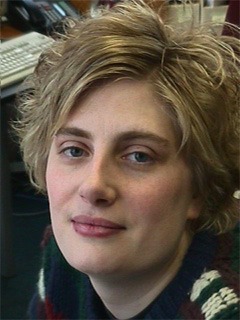I was talking about my recent posters the other day with Teetee/Pi. He was asking me questions about how to interpret Figure 3 which shows the clustered output that results after feeding similarity data into the multidimensional scaling algorithm. I didn’t have a copy of the page handy, so I pulled up the PDF version and happened to notice that the one-page version of my poster, destined for an ordinary sheet of paper, no longer had my name or my e-mail contact address on it. The only thing on it was a pointer to the three-page version of the poster on this web site.
Oops! Oops! Oops!
I was short on time when it was decided that a handout-sized version of information was needed, so I’d had my Sweetie build me the single page and the three-page versions based on the finished poster design. He got a little overzealous about saving space and, well, managed to axe the contact and affiliation information. It was missing off of the three-page version, too.
Alas, I didn’t discover this until after the Open Day, so the damage has probably already been done. Nevertheless, I’ve prepared new versions of both documents with this information intact and added page numbers, where appropriate, to boot.
Live and learn! Don’t be so concerned with the content that you fail to see the forest through the individual trees!
Downloadable Resources:
- A4 (regular page) handout sheet
- 3-page PDF version
-
 0 comments
0 comments -
7
May 04Today was the Open Day for the Human-Centred Technology group at the University of Sussex. IDEAs , my research lab, is part of the overall HCT group and a major participatant in the organization and presentation of the Open Day event, the first of which was held last year. I was unable to attend or to help out much with the organization as the event fell outside my scheduled university days. It was decided that we needed copious quantities of posters and every Ph.D. student was expected to make a poster about their project. Apparently this was timely as second- and third-year students were also expected to produce a poster for the department.
I spent oodles of time in April designing the look of the poster and then populating it with text. The finished version of the poster looked pretty good in its A1 size (~90cm by 60cm). Designing the poster in the absence of any input and with lots of nice-looking graphics to possibly incorporate led to a poster that was quite dense and text-heavy, although it had a fair bit of white space, too. A week before the event, the Lab decided that we should also have colour handouts to go along with every poster. Just shrinking down my poster from its large A1 size to A4 (regular paper size) resulted in a page that was legible (but not for readers with poor vision) with tiny graphics. The EinSweetie, who had more time, took the original poster and produced a handout version with not quite so much of the text and graphics on it. As a lot of the crucial detail had been cut, we also decided to make a short multi-page PDF version of the original poster text which could be downloaded. The URL was included on the handout sheet.
Doing the poster was very interesting, especially after my longish absence from working on my Ph.D., as it helped remind me of some of the major issues arising out of my research. A look at the big picture is often very helpful in clarifying your position and your journey. My examination or generation of the big picture led to me to realize that I was developing the fingerprints and the methodology for producing them, but then I wasn’t using the notion of the fingerprint itself anywhere after that point — something I’d completely overlooked, being caught up in the minutia of analysis for ages. I was so struck by this and other revelations that I had them make up a second laminated full-page version of my poster to hang in my office to remind me of the big picture. Life is so much improved when you can see where you’re going.
Downloadable Resources:
- A4 (regular page) handout sheet
- 3-page PDF version -
8
Mar 04
As part of my tasks, I need to acquire a suitable image of myself plus put 30 words of copy together for the annual Human-Centred Technologies brochure. 30 words isn’t very much, and I wasn’t quite sure whether those should be about me or about my project or about both. In the meantime, I set the EinSweetie to sorting out possible pictures. I dislike having my picture taken, so our collection isn’t vast and many of the pictures were taken outside where I’m wearing my sunglasses.
Here’s the picture I chose for myself. Even though it’s several years old, it was the best we could find on short notice and spending several hours trawling through iPhoto.
That still left the 30 words. I settled on the following 31 words:
Michelle concentrates on Internet information retrieval: improving the indexing and return of search engine results using semantic relations. She is an award-winning Open University lecturer, incorporating IT into distance education.
Not quite 30 words, but close enough.







